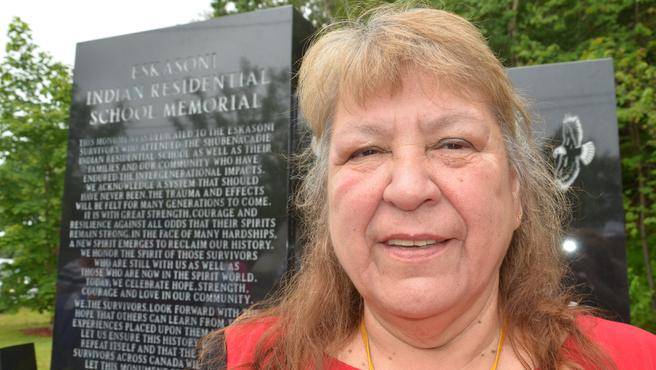A Monument to Survival
By Aaron Beswick Truro Bureau
In 1955, a government Indian agent told Margaret Johnson that she had too many children. On Friday, one of those children, now herself a mother, stood in front of a black granite memorial to the residential school system. “There were 13 of us, but I never remember being cold or hungry at home,” said Lottie Johnson. “We always had a cow and a pig and chickens and each other.” She and eight of her siblings were packed on a train and sent to the Shubenacadie Indian Residential School. There, they were beaten for speaking Mi’kmaq or for running or showing disobedience. They grew up away from their parents, along with aboriginal children from across Nova Scotia. All of Eskasoni on Friday was remembering the residential school system and the harm that travelled through ensuing generations like a wave refusing to break against the shore. Many of the 70 survivors of the system gathered before the granite slab and removed a sheet to reveal the promise carved into it. It’s a promise from them to their children and grandchildren not to pass on the harm of substance abuse and anger that has filled many of their lives. “In February, I apologized to my kids for the path I followed of drinking and drugs,” said Georgina Doucette, 70. Like Johnson, she took to drinking after leaving the residential school. By 17, she was married and drank while raising her own eight children and the seven she adopted. “Neither of us had that proper upbringing; never got to learn how to raise children from our parents because we were taken away,” said Doucette, who quit drinking on New Year’s Day 1987 after 27 years “on the bottle.” “I carry a lot of guilt because I didn’t want to pass on to my children my crap. We need to break the cycle.” For her part, Johnson quit drinking in 1979. Of the four children she gave up to social services while living and drinking in Boston, she’s only heard from one. She’s filled her life in recent years working as an addictions counsellor on the reserve, telling her story as a warning to others. She led a group of survivors in making a proposal to the federal government for funding for the monument under the program that followed Prime Minister Stephen Harper’s apology for the residential school system. Events leading up to the monument’s unveiling included presentations on fetal alcohol syndrome, discussions on substance abuse, traditional craft instruction and the sharing of personal stories. “I find sharing my story helps with the pain,” said Doucette. “And if we can share our stories with our young people, we can help stop that self abuse. There’s a lot of water ahead, but we’re trying.”
|
.
Any original material on these pages is copyright © BishopAccountability.org 2004. Reproduce freely with attribution.
